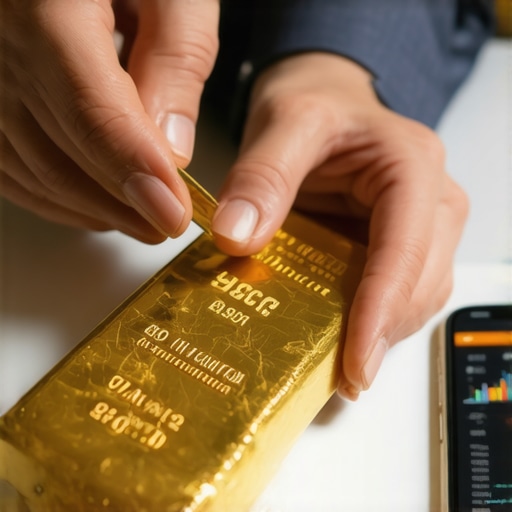Understanding the Landscape of Gold Investment
Investing in gold has long been regarded as a safe haven for wealth preservation and a hedge against economic uncertainty. As global markets fluctuate and financial crises loom, the allure of gold becomes even more pronounced. However, before diving into the world of gold investment, it is essential to understand the risks and rewards associated with this precious metal.
The Allure of Gold: Why Invest?
Gold has intrinsic value, rooted in its scarcity and historical significance. Investors often turn to gold during times of inflation or geopolitical instability. Its role as an inflation hedge is well-documented, as it tends to maintain its value when fiat currencies decline. Additionally, gold can diversify an investment portfolio, providing stability amidst volatility in stocks and bonds.
Key Rewards of Investing in Gold
1. Hedge Against Inflation: Historically, gold has served as a protective barrier against the eroding power of inflation. As prices rise, so does the value of gold, making it a reliable store of wealth.
2. Safe Haven Asset: In times of crisis, gold’s value often increases. Investors flock to gold as a safe haven, driving up its price and providing a cushion against market downturns.
3. Portfolio Diversification: Including gold in your investment strategy can lower overall risk. By diversifying your assets, you can mitigate losses during market fluctuations.
Understanding the Risks of Gold Investment
Despite the many benefits, investing in gold is not without its challenges. Here are some key risks to consider:
1. Market Volatility: Gold prices can be unpredictable, influenced by various factors, including economic data, interest rates, and geopolitical events. This volatility can lead to significant financial losses.
2. Storage and Insurance Costs: Physical gold requires secure storage and insurance, adding to the overall cost of investment. Investors must factor in these expenses when calculating potential returns.
3. Liquidity Issues: While gold is a universally recognized asset, selling physical gold can sometimes prove challenging. Investors may face delays or unfavorable pricing when trying to liquidate their holdings.
Strategies for Successful Gold Investment
To maximize the benefits of gold investment, consider employing strategic approaches. Investment strategies for gold can help you navigate the complexities of the market. Whether you choose to invest in physical gold, gold ETFs, or gold mining stocks, understanding the market dynamics is crucial.
In conclusion, investing in gold presents a blend of risks and rewards that can significantly impact your financial future. By carefully weighing these factors and employing informed strategies, you can enhance your investment portfolio and secure your wealth against uncertainties.
Diverse Gold Investment Options
When it comes to investing in gold, there are various avenues to explore. Understanding these options is crucial for tailoring your investment strategy to fit your financial goals. From physical gold assets to modern financial instruments, the landscape is rich with possibilities.
Physical Gold: Coins and Bars
Investing in physical gold typically involves purchasing gold coins or bars. This tangible form of gold provides a sense of security and ownership that many investors appreciate. However, it is essential to consider factors such as storage and insurance costs, which can affect the overall return on investment.
Gold ETFs: A Modern Approach
Gold Exchange-Traded Funds (ETFs) offer a convenient way to invest in gold without the hassle of physical storage. These funds track the price of gold and are traded on stock exchanges, providing liquidity and ease of access. For investors looking for diversification, maximizing returns with gold ETFs is a strategic choice.
Gold Mining Stocks: Investing in Production
Another compelling investment avenue is through gold mining stocks. By investing in companies that mine gold, you can benefit from the rising prices of gold while also capitalizing on the operational efficiencies of these companies. However, it’s important to conduct thorough research on the mining companies’ financial health and production capabilities.
Market Trends Influencing Gold Prices
Understanding the market trends that influence gold prices is vital for making informed investment decisions. Several key factors can drive the demand and supply dynamics of gold, making it essential to stay updated on global economic conditions.
Geopolitical Events and Economic Uncertainty
Geopolitical events often lead to increased demand for gold as a safe haven asset. Investors tend to flock to gold during times of uncertainty, driving up its price. Keeping an eye on global events and their potential impact on the economy can provide valuable insights into when to invest.
Interest Rates and Inflation
Interest rates significantly impact gold prices. Typically, when interest rates are low, gold becomes more attractive as an investment since it does not yield interest like bonds or savings accounts. Furthermore, the relationship between gold and inflation is crucial; as inflation rises, so does the demand for gold as a hedge. Understanding these economic indicators can guide investors in their timing and strategy.
Expert Tips for Gold Investment Success
To navigate the complexities of gold investment successfully, consider the following expert tips:
1. Do Your Research: Knowledge is power in the investment world. Stay informed about market trends, economic indicators, and global events affecting gold prices.
2. Diversify Your Portfolio: Avoid putting all your eggs in one basket. Diversifying your investments across various asset classes, including gold, can help minimize risks.
3. Set Clear Investment Goals: Define your investment objectives, whether it’s short-term gains or long-term wealth preservation. Having clear goals will aid in developing a focused investment strategy.
4. Consult with Experts: If you’re unsure about your investment strategy, consider consulting with a financial advisor who specializes in gold investments. Their expertise can provide personalized guidance.
In summary, navigating the world of gold investment requires a nuanced understanding of the available options, market trends, and strategic planning. By leveraging these insights and adopting a well-rounded approach, you can enhance your investment portfolio and capitalize on the potential of gold as a wealth-preserving asset.
Understanding the Risks of Gold Investments
Investing in gold, while often seen as a safe haven, carries its own set of risks. Awareness of these risks is essential for making informed decisions. A key consideration is the volatility of gold prices, which can fluctuate based on various economic indicators and market sentiments. Investors must be prepared for price swings and the possibility of short-term losses, particularly during periods of economic stability when gold may not be in high demand.
Market Volatility and Price Fluctuations
Market volatility is a significant factor that can affect gold investments. Prices can rise sharply in times of crisis but may also decline when economic conditions improve. Understanding how global demand impacts gold prices can help investors better navigate these fluctuations. Analyzing historical data and market trends provides insights into potential future movements, allowing investors to time their purchases more effectively.
Liquidity Concerns with Physical Gold
While physical gold investments offer tangible benefits, they can also present liquidity challenges. Selling physical gold may not be as quick or straightforward as trading ETFs or stocks. Investors should account for potential selling costs and market demand when considering physical gold as part of their investment strategy. Understanding the role of gold in a balanced investment portfolio can provide clarity on how to integrate physical gold effectively while maintaining liquidity.
Future Trends in Gold Investment
Looking ahead, several trends are shaping the gold investment landscape. By staying informed about these trends, investors can position themselves strategically to capitalize on emerging opportunities.
Growing Demand for Sustainable Gold
As environmental consciousness rises, there is a growing demand for sustainably sourced gold. Investors are increasingly interested in ethical mining practices and the impact of their investments on communities and ecosystems. This shift towards sustainability can influence gold prices and investment choices. Staying updated on gold demand trends will be crucial for understanding market dynamics.
Technological Advancements in Gold Trading
Technological advancements are transforming the way investors trade gold. Online platforms and mobile trading apps have made it easier than ever to buy and sell gold. Furthermore, the rise of blockchain technology is introducing new possibilities for gold-backed cryptocurrencies, which could revolutionize how gold is perceived as an investment asset. As these innovations continue to evolve, investors should keep an eye on effective gold trading techniques to stay competitive in the market.
Final Thoughts on Gold Investment
Investing in gold can be a rewarding venture when approached with knowledge and strategy. By understanding the risks, staying informed about market trends, and adapting to new technologies, investors can enhance their chances of success. As always, consulting with financial experts can provide valuable insights tailored to individual investment goals.
Understanding the Economic Factors Influencing Gold Prices
The price of gold is significantly influenced by various economic factors. Macroeconomic indicators such as inflation rates, interest rates, and currency fluctuations play a critical role in shaping investor sentiment towards gold. For instance, rising inflation often leads investors to flock to gold as a hedge, which in turn drives prices up. Therefore, keeping an eye on global factors influencing gold demand trends is essential for making informed investment decisions.
Interest Rates and Their Impact on Gold Investment
Interest rates are a vital component of the gold price equation. Generally, when interest rates rise, the opportunity cost of holding gold increases, leading to decreased demand for the metal. Conversely, lower interest rates make gold more attractive as an investment. Investors should monitor central bank policies and economic forecasts to gauge potential interest rate changes, which could impact their gold investment strategies. Understanding gold versus stocks can further clarify how these economic indicators interplay in the investment landscape.
Psychological Factors Affecting Gold Prices
The psychology of investors plays a crucial role in gold pricing. Fear and uncertainty often drive demand for gold, particularly during economic downturns or geopolitical tensions. This phenomenon creates a feedback loop where rising prices attract even more investors, further inflating the price. Recognizing how gold serves as a hedge against inflation can help investors understand the psychological dynamics at play in the gold market.
Market Sentiment and Investor Behavior
Investor sentiment can be volatile, influenced by news events, market trends, and economic conditions. For example, during times of crisis, such as financial market crashes or political instability, gold is often viewed as a safe haven. Tracking recent trends in gold price forecasts can provide insights into how current events might affect investor psychology and gold demand.
Strategies for Successful Gold Investment
To maximize returns on gold investments, it’s essential to adopt effective strategies. Diversifying your investment portfolio by including various forms of gold, such as coins, bars, and ETFs, can mitigate risks and enhance potential gains. Additionally, staying informed about the latest market trends and economic indicators allows investors to make timely decisions.
Educating Yourself on Gold Investment Types
Understanding the different types of gold investments is crucial for informed decision-making. Each type, whether physical gold, gold ETFs, or mining stocks, has its own risk profile and liquidity characteristics. Resources such as breaking down the best gold investment types can offer valuable insights into how to strategically allocate assets within your portfolio.
Final Reminders for Gold Investors
Investing in gold requires a blend of knowledge, strategy, and awareness of market dynamics. By understanding the factors that influence gold prices and adopting effective investment strategies, you can significantly enhance your investment outcomes. As always, it’s advisable to consult with financial experts who can provide tailored advice based on your individual circumstances and investment goals.
Comprehensive FAQs on Gold Investment
What are the main factors that influence the price of gold?
The price of gold is primarily influenced by economic factors such as inflation rates, interest rates, and currency fluctuations, as well as psychological factors like investor sentiment during economic uncertainty.
Is gold a good investment in a recession?
Yes, gold is often considered a safe haven during recessions. Investors typically flock to gold to protect their wealth from economic downturns, making it a potentially strong investment during such times.
How can I invest in gold?
You can invest in gold through various methods, including purchasing physical gold (coins and bars), investing in gold ETFs, or buying stocks in gold mining companies. Each option has its own advantages and risks.
What is the difference between gold bullion and gold coins?
Gold bullion refers to gold in bulk form, typically bars, and is valued based on its weight and purity. Gold coins, on the other hand, are minted and often have a face value, collectible value, and are typically sold at a premium over the spot price of gold.
How does inflation affect gold prices?
Inflation generally drives gold prices up since investors seek gold as a hedge against declining purchasing power. As inflation rises, the demand for gold increases, contributing to higher prices.
What are the risks associated with investing in gold?
Investing in gold carries certain risks, including price volatility, storage costs for physical gold, and potential liquidity issues. It’s essential to understand these risks and how they fit within your overall investment strategy.
What is the best time to buy gold?
The best time to buy gold can vary, but generally, it’s advisable to purchase during periods of low prices or economic uncertainty when demand is likely to rise. Regularly monitoring market trends can help identify opportune moments.
Can gold investments provide passive income?
Gold itself does not yield interest or dividends. However, investing in gold mining stocks or gold ETFs that pay dividends can potentially provide a form of passive income.
How much of my portfolio should be in gold?
Financial experts often recommend allocating between 5% to 10% of your investment portfolio in gold, depending on your risk tolerance and overall investment strategy.
What are some common mistakes to avoid when investing in gold?
Common mistakes include failing to do thorough research, investing too heavily in gold without diversification, and letting emotional decisions drive buying or selling actions. Staying informed and maintaining a balanced approach is key to successful gold investment.
Authority Resources for Gold Investment
For investors looking to deepen their understanding of gold and its market dynamics, here are some trusted resources:
- World Gold Council – A leading authority on gold, providing insights into the gold market and investment opportunities.
- Kitco News – Offers real-time gold market data, news, and analysis.
- Investopedia – A comprehensive resource for financial concepts, including gold investment strategies.
- Bloomberg Markets – Provides news and insights into global financial markets, including commodities like gold.
- CNBC Gold – Features updates and expert opinions on gold prices and market trends.
- Fidelity Investments – Offers educational resources and investment options related to gold.
Conclusion
In conclusion, investing in gold is a multifaceted decision shaped by economic indicators, psychological factors, and investment strategies. Understanding these elements, combined with diligent research and resource utilization, can greatly enhance your investment outcomes in the gold market. By leveraging the insights provided in this guide, you are better equipped to navigate the complexities of gold investment and make informed decisions that align with your financial goals.











I found the discussion about the risks and rewards of investing in gold quite comprehensive. One challenge I’ve personally encountered is balancing the allure of gold as a hedge against inflation with its price volatility. While gold tends to hold value during economic downturns, its short-term price swings can be unsettling, especially for newer investors like myself. I’ve also struggled to decide between physical gold and gold ETFs; physical gold provides a tangible asset but comes with storage and liquidity concerns, whereas ETFs offer easier access but less direct ownership. The point about the rising demand for sustainable gold is insightful—I’m curious whether investing in ethically sourced gold might impact long-term value differently compared to traditional gold. Moreover, with the technological advancements in gold trading, especially blockchain-backed assets, I wonder how these will shape accessibility and trust in gold investments moving forward. Have others had experience balancing these factors or successfully navigated these choices? It would be helpful to hear different perspectives on selecting between physical gold and ETFs or on integrating sustainability into gold investment strategies.